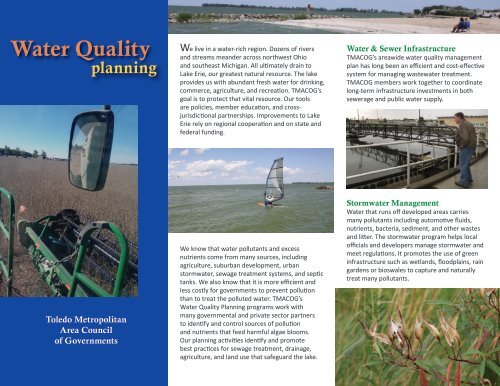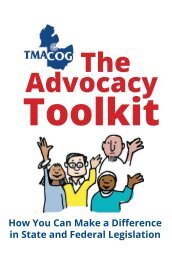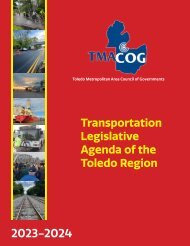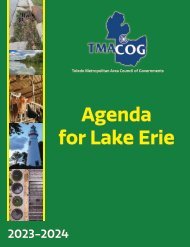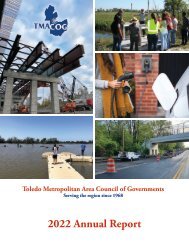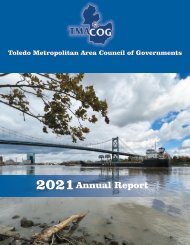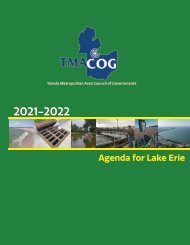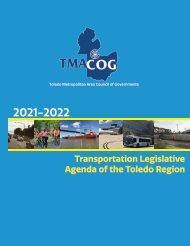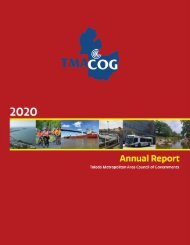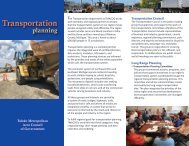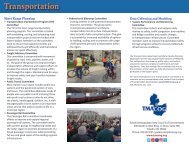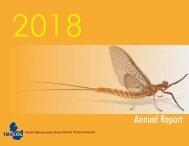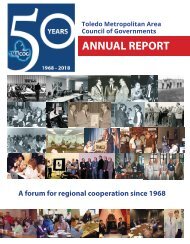TMACOG Water Quality Department
Learn more about the Toledo Metropolitan Area of Governments Water Quality department
Learn more about the Toledo Metropolitan Area of Governments Water Quality department
- No tags were found...
Create successful ePaper yourself
Turn your PDF publications into a flip-book with our unique Google optimized e-Paper software.
<strong>Water</strong> <strong>Quality</strong><br />
planning<br />
We live in a water-rich region. Dozens of rivers<br />
and streams meander across northwest Ohio<br />
and southeast Michigan. All ultimately drain to<br />
Lake Erie, our greatest natural resource. The lake<br />
provides us with abundant fresh water for drinking,<br />
commerce, agriculture, and recreation. <strong>TMACOG</strong>’s<br />
goal is to protect that vital resource. Our tools<br />
are policies, member education, and crossjurisdictional<br />
partnerships. Improvements to Lake<br />
Erie rely on regional cooperation and on state and<br />
federal funding.<br />
<strong>Water</strong> & Sewer Infrastructure<br />
<strong>TMACOG</strong>’s areawide water quality management<br />
plan has long been an efficient and cost-effective<br />
system for managing wastewater treatment.<br />
<strong>TMACOG</strong> members work together to coordinate<br />
long-term infrastructure investments in both<br />
sewerage and public water supply.<br />
Toledo Metropolitan<br />
Area Council<br />
of Governments<br />
We know that water pollutants and excess<br />
nutrients come from many sources, including<br />
agriculture, suburban development, urban<br />
stormwater, sewage treatment systems, and septic<br />
tanks. We also know that it is more efficient and<br />
less costly for governments to prevent pollution<br />
than to treat the polluted water. <strong>TMACOG</strong>’s<br />
<strong>Water</strong> <strong>Quality</strong> Planning programs work with<br />
many governmental and private sector partners<br />
to identify and control sources of pollution<br />
and nutrients that feed harmful algae blooms.<br />
Our planning activities identify and promote<br />
best practices for sewage treatment, drainage,<br />
agriculture, and land use that safeguard the lake.<br />
Stormwater Management<br />
<strong>Water</strong> that runs off developed areas carries<br />
many pollutants including automotive fluids,<br />
nutrients, bacteria, sediment, and other wastes<br />
and litter. The stormwater program helps local<br />
officials and developers manage stormwater and<br />
meet regulations. It promotes the use of green<br />
infrastructure such as wetlands, floodplains, rain<br />
gardens or bioswales to capture and naturally<br />
treat many pollutants.
<strong>Water</strong> <strong>Quality</strong><br />
Non-point Source Pollution<br />
With more than 70 percent of our region<br />
dedicated to agriculture, farming is a vital part of<br />
our economy and regional community. Reducing<br />
runoff from agricultural land and other nonpoint<br />
sources protects Lake Erie by controlling<br />
nutrients. <strong>TMACOG</strong> coordinates regional nonpoint<br />
source planning and supports agricultural<br />
best management practices that control the<br />
drainage of nutrient-laden water from farm fields.<br />
Education and Training<br />
<strong>TMACOG</strong> hosts educational programs for elected<br />
officials, stakeholder agencies, the general<br />
public, and students. The Student <strong>Water</strong>shed<br />
Watch involves middle-school and high-school<br />
classrooms in hands-on water quality research<br />
in local waterways. <strong>TMACOG</strong> presentations at<br />
meetings and special events provide learning<br />
opportunities and continuing education<br />
programs for public officials and private sector<br />
stakeholders. <strong>TMACOG</strong> provides training for<br />
municipal maintenance staff as well as water and<br />
wastewater plant operators.<br />
The Power of Partnerships<br />
Regular <strong>TMACOG</strong> committee meetings create<br />
the personal connections, professional rapport,<br />
and trust that are key to addressing a mutual<br />
commitment to water quality. When public<br />
officials, local non-profits, and the private sector<br />
steadily work together in non-partisan <strong>TMACOG</strong><br />
forums, strong relationships lead to effective<br />
action.<br />
<strong>TMACOG</strong>’s <strong>Water</strong> <strong>Quality</strong> committees<br />
welcome your involvement<br />
• <strong>Water</strong> <strong>Quality</strong> Council<br />
• <strong>Water</strong>sheds Committee<br />
• Wastewater Committee<br />
• Stormwater Coalition<br />
• Public <strong>Water</strong> Supply Committee<br />
• Agriculture Committee<br />
The <strong>Water</strong> <strong>Quality</strong> Planning department and the<br />
Transportation department are the two programmatic<br />
divisions of <strong>TMACOG</strong>. The staff perform the research,<br />
public input, and analysis required to maintain compliance<br />
with federal and state regulations. They also manage the<br />
committees that ensure that members of the region are fully<br />
informed and can fully participate in the region’s plans.<br />
For more information on any <strong>Water</strong> <strong>Quality</strong> committee or to<br />
comment on any water quality concern, contact Director of<br />
<strong>Water</strong> <strong>Quality</strong> Planning Kari Gerwin: gerwin@tmacog.org or<br />
419.241.9155, ext. 1103.<br />
Toledo Metropolitan Area Council of Governments<br />
300 Martin Luther King, Jr. Drive, Suite 300<br />
Toledo, OH 43604<br />
Phone: 419.241.9155 | public.info@tmacog.org<br />
www.tmacog.org


